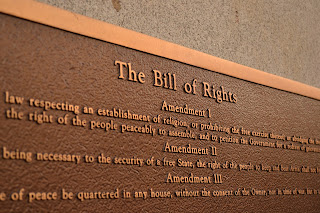As we look ahead to its 224th birthday on December 15, let us remember and retrace some basic facts about the first 10 amendments to the United States Constitution which is also collectively known as the Bill of Rights.
 |
| The Bill of Rights |
1. What is the “Bill of Rights” and how did it come about?
The collective name “Bill of Rights” refers to the first ten amendments to the U.S. Constitution. Originally, the Congress proposed 12 amendments to the Constitution on September 25, 1789, but only numbers three through twelve were approved on December 15, 1791. One article that deals with the number and appointments of electoral districts did not become part of the U.S. Constitution. The second article that limits pay raises for Congress members was finally ratified two centuries later and is now known as the 27th amendment.
James Madison initially proposed the U.S. Bill of Rights as a resolution to the opposition of the proposed draft of the Constitution. Anti-Federalists were gravely concerned about the basic principles of human liberty which were not seemingly protected by the Constitution. According to those who opposed the Constitution, it failed to look after the personal freedoms of the public as well as regulate the federal government’s power.
2. What is inside the Bill of Rights and where was it inspired from?
The first ten amendments to the U.S. Constitution were heavily influenced by the Virginia Declaration of Rights in 1776 by George Mason, as well as the English Bill of Rights 1689 and the Magna Carta (1215). The Bill of Rights specified the freedoms of the people not designated inside the U.S. Constitution such as freedom of religion, speech, press, free assembly and petition; the right to bear arms; freedom against unreasonable searches and seizures; rights in criminal cases; rights to a fair trial; rights in civil cases; freedom against excessive bail, fines, and cruel and unusual punishments; rights retained by the people which are not particularly mentioned in the U.S. Constitution as well as the powers retained by the states and the people.
3. How many original copies of the Bill of Rights were produced and where can they be found today?
There are 14 original copies of the U.S. Bill of Rights as commissioned by George Washington. The 13 handwritten copies were for the 13 original colonies. One original, handwritten copy of the Bill of Rights can be found at the National Archives in Washington, D.C.
US Constitution Bill of Rights Quiz
-To our freedom and liberty,
Norm Novitsky and the In Search of Liberty Team
Thank you for taking the time to be a part of our journey as we continue to work toward enlightening and helping Americans with this highly entertaining, informative movie for people from all walks of life on the importance of the US Constitution, and what it means for our freedom, our way of life and our continued prosperity. Support and learn more about our film In Search of Liberty.
Connect with us on all channels herehttp://www.peepjuice.com/constitutionalrights



No comments:
Post a Comment